Phosphor Art
Trina Wydmanski – Agent
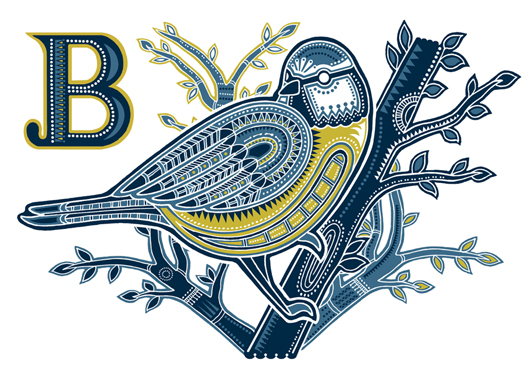
Blue tit by Poonam Mistry.
Having worked with Phosphor Art, you would have seen a change in commissioning style across time. Where do you see the landscape of commissioning going this year?
Advances in technology have transformed almost every area of life since I started as an agent over 30 years ago. The biggest change to the commissioning process is in how we are briefed. Back in the 1980s, we always went in to the client’s offices to pick up a brief. We discussed it with a dedicated Art Buyer and the Art Director face-to-face. Most Art Directors could draw well but if they couldn’t produce a tight Magic Marker layout themselves, they had a visualiser do it for them.
If I could plant ideas in the ‘commissioning landscape’, I’d like to see a closer collaboration between Art Directors and illustrators – with the agent handling the fees and rights side of things so the illustrator can concentrate on being creative in response to a brief. This is already happening to an extent, as our illustrators are frequently asked to supply a rough visual from a very sketchy brief, which then prompts a more detailed brief and, often, more useful reference. The best work results from focussed – but not prescriptive – briefing that allows a motivated artist freedom of expression.
I’d also like to see less ‘creativity by committee’. There are people involved in some jobs who serve no creative purpose whatsoever and inevitably contribute nothing other than occupying a seat at a meeting.
Above all, I’d like to see commissioners taking a few more risks – whether in advertising or publishing. Illustration can help something get noticed and really stand out. Give some new illustrators a chance; play less safe. The fact that a reputable agent (sadly there are other sorts!) has taken someone on means they consider the style has client and consumer appeal.
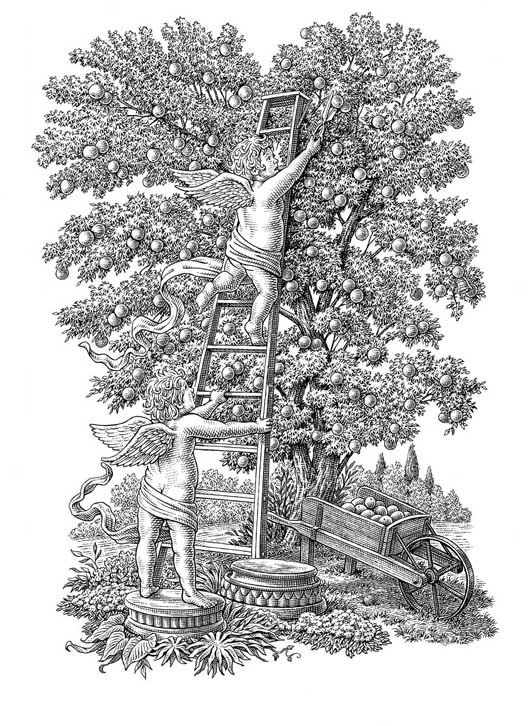
Ted Baker Wallpaper by Dave Hopkins.
As illustration is ever changing, how do you maintain an upkeep of the sector with your illustrators and their styles?
We have a core group of artists we’ve represented for decades who are always in demand. It fluctuates a bit with trends but their styles and techniques have timeless, classic qualities. They are all superbly skilled.
Most artists are naturally aware of current cultural trends and should be able to refresh their styles over the years. We encourage ours to keep abreast of what’s currently popular and to develop their own styles with an eye to the area they are targeting.
Many illustrators have long careers because they are able to reinvent themselves and develop new areas. We tend to discuss with them the best direction to take. Advertising reflects current trends, so we can sometimes prepare if we spot a style that is likely to be commissioned – as we did with Graffiti some years back.
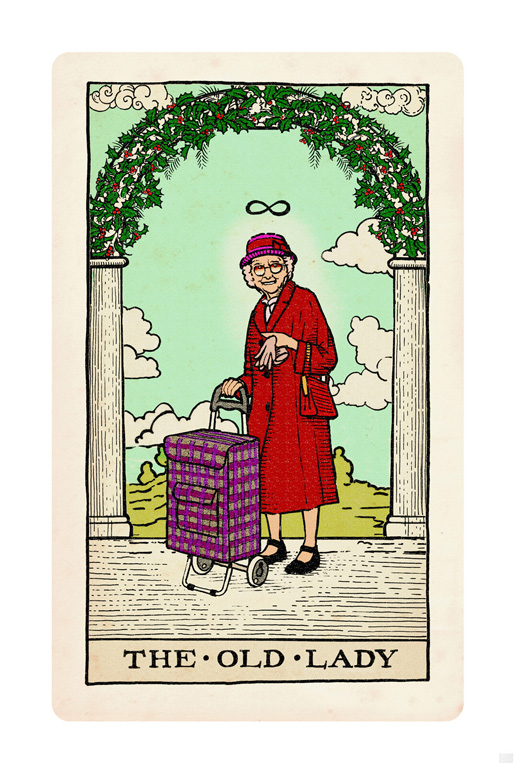
VW old lady Tarot card by Jon Rogers.
How, initially, should illustrators approach Phopshor Art?
Illustrators should send in a few samples by email with a short note about themselves and a link to their website. Sending just a link on its own is not enough.
Perhaps I shouldn’t say this, but we do look at everything we get sent. After all, we can tell at a glance whether someone has a chance of being commissioned. We try to return printed samples but we won’t if it involves expense for us or hours standing in a Post Office queue.
We are always honest and say if we are not currently taking on any more artists. That said, we will make an exception for outstanding talent. (That makes me the Agent with the Iron Whim!)
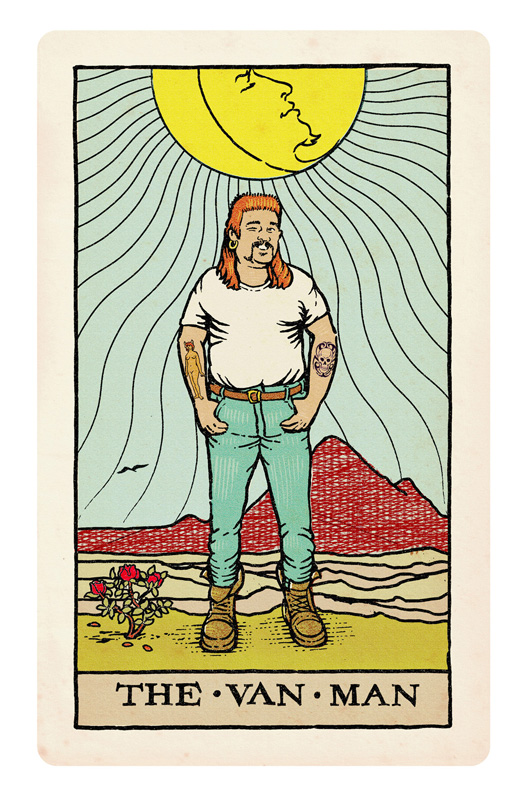
VW van man tarot card by Jon Rogers.
When an illustrator approaches Phosphor Art, what are the first three factors that you look for?
First off, I look for an original and interesting style that I feel could work in our key markets. Secondly, I like to see a professional approach and a love of their craft shine through in the samples. Thirdly, if someone can articulate their talents and sell themselves, they have a better chance of succeeding. (I’m not talking about being arrogant or pushy – we are not interested in Prima Donnas, however talented they might be!)
What and how do you feel the agent and artist relationship works best?
It works differently with each artist. I have many, mainly the more senior ones who have been with us for years and are like family – they tend not to want to deal with clients or money and just enjoy creating the illustrations and leave everything else to me. Others are happy to speak with clients and are proactive with their promotions…. and our website, portfolios etc.
As we are a small company and always will be, I work closely with the artist throughout the entire creative process. I prefer this to just doing the negotiation of the fees and contracts and then taking delivery of the finished job. Having considerable experience really helps with what I believe to be my most crucial role: getting to the heart of a brief. I can almost always determine what a client really has in mind. I can then pass that understanding on to the artist in a creative way to help them create their best work. As agents, we have twin priorities: the professional welfare of our artists and our clients’ satisfaction. In that order – and they are mutually beneficial.
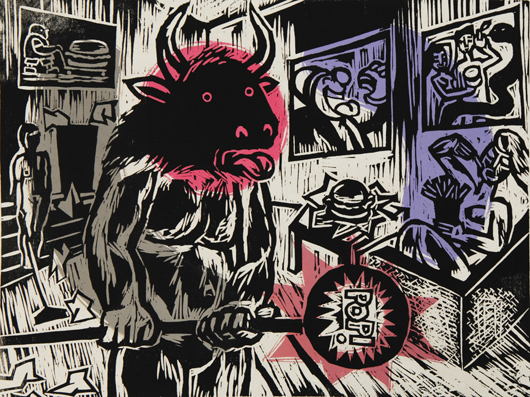
What makes burgers so appealing by Gerry Baptist.
Do you still find a certain value within showing clients a physical portfolio, or do you take the digital route?
I’m smiling because we have a specially-built rack in the office which until last week held dozens of those ubiquitous and uniform black portfolios everyone used to use. We’ve had a serious cull, but we have no plans to get rid of all of them. In the past couple of years we’ve been more creative in our presentation. For example, we’ve commissioned bespoke portfolios from a newly-graduated bookbinder with endpapers made from prints of the artist’s work.
If I go into a company to present our credentials to one person I can use my iPad. If I’m seeing a department, I present work on my iPad, but it’s useful also to take along a number of portfolios so creatives have something to look through when I’m talking to one of their colleagues.
Emailing pdfs or a link to a landing page is more immediate and cheaper than biking round a book. But, if a client or serious prospect wants a printed portfolio – and fewer and fewer do – we will supply one.
Portfolios definitely have a role for students as they prepare to look for commissions or representation. It gives something to talk around, and deciding on a running order for the illustrations is useful practice in selling yourself.
What would you advise for illustrators who are looking to join an Illustration agency?
Be honest with yourself and be clear about what makes your work different. Only show work that is in your own style and in which you believe. (Don’t try to best guess what any agent is looking for.) Draw up a shortlist of agents by looking at the type of work they have on their websites and decide whether yours will be complementary and fit in. There are certain genres no one will come to us for, so we would never take on someone who produces work in those styles. And finally don’t expect miracles – immediate or otherwise.
Back to News Page
